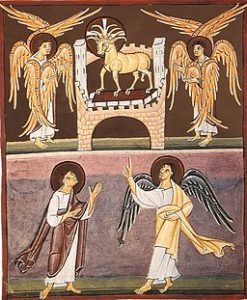 The dispensational premillennialist camp has been quite influential in Evangelical circles. Dispensational interpreters are known for four emphases. First, they emphasize the pretribulational rapture of the church. According to this view, “Christ’s return will occur in two stages: the first one for his church, which will be spared the Great Tribulation; the second one in power and glory to conquer his enemies” (Pate 29). As a result, the rapture of the church must occur sometime in Revelation before the beginning of the Great Tribulation. Second, they also emphasize the distinction between ethnic Israel and the church. Therefore, when John speaks about “Israel” in Revelation 7:4, he is speaking about ethnic Israel and not about the church. Third, they are committed to premillennialism. Premillennialists believe that Christ will come back to conquer the Beast (Rev. 19:11-21). After that victory, he will set up his kingdom and rule with his people for 1,000 years. Fourth, dispensational interpreters are generally committed to interpreting prophecies literally. As a result, they usually favor a literal, rather than symbolic, interpretation of the numbers in the book of Revelation.
The dispensational premillennialist camp has been quite influential in Evangelical circles. Dispensational interpreters are known for four emphases. First, they emphasize the pretribulational rapture of the church. According to this view, “Christ’s return will occur in two stages: the first one for his church, which will be spared the Great Tribulation; the second one in power and glory to conquer his enemies” (Pate 29). As a result, the rapture of the church must occur sometime in Revelation before the beginning of the Great Tribulation. Second, they also emphasize the distinction between ethnic Israel and the church. Therefore, when John speaks about “Israel” in Revelation 7:4, he is speaking about ethnic Israel and not about the church. Third, they are committed to premillennialism. Premillennialists believe that Christ will come back to conquer the Beast (Rev. 19:11-21). After that victory, he will set up his kingdom and rule with his people for 1,000 years. Fourth, dispensational interpreters are generally committed to interpreting prophecies literally. As a result, they usually favor a literal, rather than symbolic, interpretation of the numbers in the book of Revelation.
The dispensationalist camp now has its own subdivisions, which include classical and progressive forms of dispensationalism (Pate 29-30). With the exception of the four emphases listed above, progressive dispensationalists share a good bit of common ground with historic premillennialists. For instance, Pate emphasizes the importance of approaching Revelation with an “already/not yet hermeneutic” (31-34). This allows him to relate some of Revelation’s prophecies to the first century and to the time period before the rapture, including the partial fulfillment of the first six seal judgments (Rev. 6). Dispensationalists who are more traditional are focused more on the future. Revelation’s prophecies find their fulfillment in the future, at the time of the rapture and the glorious return of Christ.1
Notes:
1 Interestingly, it has been common for dispensational interpreters to interpret the seven letters to the seven churches in a historicist manner. The letters may have a historical referent, but also anticipate “the seven periods of church history from the time of composition to the coming of Christ for the church” (Thomas, Revelation 1-7, 507; see also 505-515).
Sources:
- C. Marvin Pate, Four Views of the Book of Revelation. Counterpoints. Grand Rapids: Zondervan, 1998.
- Robert L. Thomas, Revelation 1-7: An Exegetical Commentary. Chicago: Moody Press, 1992.
- These paragraphs represent an edited portion of my book:
Paul Hoskins, The Book of Revelation: A Theological and Exegetical Commentary, pp. 33-34 (these pages provide further sources and footnotes that I have omitted above).

